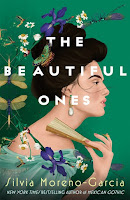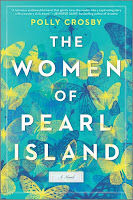***** BLOG TOUR *****
Book Review
The recurring statement of this book set on an isolated island off the coast of England is, "The sea is made up of unspeakable sadness." As is this book. At one point, a further restatement is made. "The sea will give up its secrets when it wishes." This book decides to keep many of its secrets. What actually happened on this island? How did Marianne end up in the predicament she found herself in - both as a young woman and now as an old woman? What is Tartelin's back story? Is there a further connection between Marianne, Nan, and Tartelin? Why? "There's something about this place that I can't quite get a grip on. It's as if it's trying to tell me something, but I don't know the language."
This slow-moving book leaves many questions unanswered. This is a book very much about the "where" and the "who"? The descriptions of Dohhalund, the small island setting of this book, conjure up not as much an image as a feeling of abandonment, desolation, and mystery. An abandoned military installation, salt flats, wells that appear and disappear with the sea, a crumbling old house, and the odd, intriguing creatures - human and animal - that are found here. The feeling of cold and sadness permeates even as peacocks, birds, and butterflies can be found in abundance. An odd contrast.
The "who" is Marianne and Tartelin - the two voices of this book. There is a sadness to both of them. The reasons emerge somewhat throughout the book, but some I am still left wondering about. Surrounding them are the stories of other women - Marianne's mother, Nan, and even Tartelin's mother who never actually appears in the book. Each has a burden to bear and secrets of her own. Collectively, these are the "women of Pearl Island." Even for Marianne and Tartelin, by the end, I feel that I see an outline of a sketch of the women. I want some of the back story and the gaps in the story filled out. The gaps cannot be described in this review because they would lead to spoilers. Suffice it to say that the jump in Marianne story is huge - too much so to create a full picture of her as a character I invest in. Tartelin's back story is never really explained. Perhaps, a connection is hinted at towards the very end, but it is left unclear.
I am not sure what to make of the romance that is included in the book other than a reinforcement of the idea of acceptance of differences. However, in many ways, it seems extraneous to the main story of the women, and its seems rather too instant. Again, more questions than answers.
Despite the sweetness of the romance, the overall feel of the book's sadness will linger with me a while, and I will wonder what really happened. Perhaps in leaving that question and the wish that I knew, the book finds its success.
About the Author
Polly Crosby grew up on the Suffolk coast, and now lives deep in the Norfolk countryside. THE BOOK OF HIDDEN WONDERS was awarded runner up in the Bridport Prize's Peggy Chapman Andrews Award for a First Novel, and Polly also won Curtis Brown Creative's Yesterday Scholarship, which enabled her to finish the novel. She currently holds the Annabel Abbs Scholarship at the University of East Anglia, where she is studying part time for an MA in Creative Writing. THE WOMEN OF PEARL ISLAND is her second novel.
About the Book
With the same atmosphere and imagination of THE BOOK OF HIDDEN WONDERS, Polly Crosby’s new novel, THE WOMEN OF PEARL ISLAND is set on a lush, secluded island where family secrets bring together an unlikely friendship.
On a secluded island off the British coast, an elderly woman named Marianne collects butterflies and memories from her past. No longer able to catch butterflies herself, she enlists the help of a young woman named Tartelin who has peculiar birthmark on her cheek. Tartelin’s mother has recently passed, leaving her unmoored and eager for new beginnings on the island.
Marianne has spent most of her life on the island, her family having owned it for generations. She begins to tell her young assistant her family’s story – from the prosperous days when they harvested pearls and held banquets, to the harder times and her father’s desperate money-making schemes. But during WWII, the British government commandeered the island for nuclear testing and they were all forced to leave. Though, secret to everyone, Marianne stayed behind and experienced something she calls “the blast,” an event that changed everything for her. Now, the older woman is obsessed with tracking the changes in butterflies and other creatures on the island to prove what she witnessed so many decades before.
With a mystery spanning decades, this is an emotional and atmospheric story of a young woman coming into her own as she forges an unlikely friendship with her employer, both women grieving their pasts and together, embracing a new future.
Q&A With the Author
Which of your characters would you want to share a campfire with, and why?This is such a great question! There is a mysterious old woman on the island known only as ‘the mermaid.’ The term refers to the herring girls who used to work there in the 1920s, gutting the fish caught by the boats. I’d like to sit with her on the beach one evening, looking out to sea, and listen to her stories of long ago. I imagine she’d have quite a few tales to tell.
Can you briefly describe your writing process for us?
I tend to get a brief idea at first, maybe just a single image. After a while it begins to bloom into a story. Then I read everything I can lay my hands on about my chosen subject - in this case, butterflies, silkworms and pearl cultivation - until I cannot help but start to write! I write in the mornings, usually every day. I write on my laptop, on my phone, on paper and sometimes with voice memos. If it’s going well, I wake up each morning excited to continue. If it’s going badly, I pour myself a very large coffee before I start and a large glass of wine when I finish!
Give us an out of context quote from your book to warm our hearts.“And it’s only now, as these thoughts come to me, that I realise I don’t want to go; not yet. There is too much on this island that I don’t want to give up: there is the clear, uncompromising light of the sea. There is the taste of briny seaweed and the thrill of finding a pearl. There is the sight of a freshly caught fish, the sharing of photographs and the bright gleam of a butterfly’s wing.”
What’s the last book you read that inspired you?So many books inspire me, either by the language they use or the ideas they manage to get across so effortlessly. I recently read The Great Gatsby by F Scott Fitzgerald for the first time (I know! I can’t believe I haven’t read it before!). His prose is so lyrical, and I loved the way it described the glittering excess of that period between the wars. It made me want to write a love story set then, where for a short time, the world was full of hope and anything felt possible. So that’s what I’m trying to do right now! Wish me luck!
Name one song or artist that gets you fired up.
At The River by Groove Armada has always held a special place in my heart. It samples an old song by Patti Page, and the lyrics feel like they’re talking about the little English seaside village where I grew up (when in fact she’s singing about Cape Cod!)
‘If you’re fond of sand dunes and salty air, Quaint little villages everywhere.’
It’s also a great song to get me in the right headspace to write, especially when I’m writing about the sea.
How do you decide on a setting?With The Women of Pearl Island, the idea came from a place I knew well, called Orford Ness. It’s a desolate spit of land on the Suffolk coast. During World War Two it was taken over by the Ministry of Defence and used very secretively. Even now we don’t know exactly what went on there. The MOD left in the nineties, and for the last thirty years the ness has been left to rewild. It’s such an eerie, secretive place, where all the old crumbling military buildings have been taken over by wildlife. My island, Dohhalund, is based on that idea.
Do you come up with the hook first, or do you create characters first and then dig through until you find a hook?Quite often for me, I come up with a place first of all. With this novel, it was the island, and for the novel I’m working on now, it’s an unusual derelict mansion half-hidden in a field of reeds. These places almost feel like characters in their own right to me.
Do you take lemon or milk in your tea?Milk, but just a drop. I drink so much tea when I’m writing, especially in this cold, winter weather. I have a special mug that keeps it hot, because I get so distracted when I’m writing that I forget to drink it in time!
How do you create your characters?Quite often they come to me fully formed. Marianne Stourbridge, the old lady who owns the island in my novel, was like this. We meet her both as a teenager in the 1920s and as an extremely crotchety old woman in the present. She is quite opinionated and spoilt, but there is a sense that beneath all this, she has a fascinating story to tell.
Who would be your dream cast if WOMEN OF PEARL ISLAND became a movie?
Gosh, that’s a tricky one. I think it would be one of those very British movies, with the rude old Marianne Stourbridge played by a national treasure like Judi Dench. The young protagonist, Tartelin, would probably be someone up and coming and as yet unknown.
If you could grab lunch with a literary character who would it be?I recently read and adored Piranesi, and I’d like to sit in his beautiful halls surrounded by all the eerie, unusual statues, and watch him catch a fish for our lunch.
What are you currently reading?
I’ve just finished The Lamplighters by Emma Stonex, an incredible locked room mystery about three lighthouse men who vanish from their isolated lighthouse in the middle of the sea. The descriptions of the water and the weather are just breath-taking, and it’s packed full of secrets, which, for me, is what makes a story.
Buy Links











